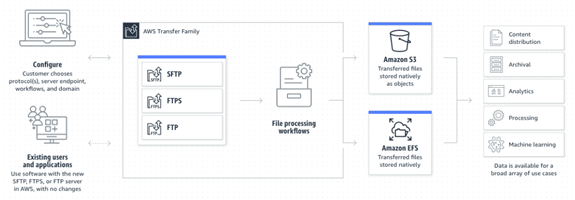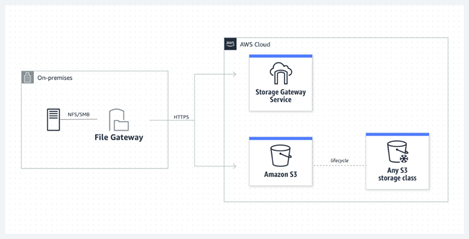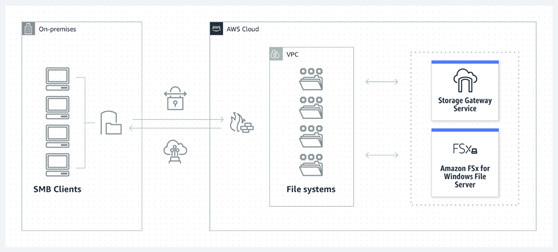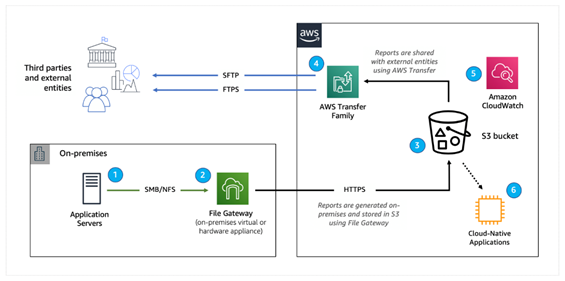How AWS Enables Transforming File Transfer with SMB, NFS, FTP, FTPS, and SFTP
Publish Date: March 22, 2024Meet YASH at the AWS booth at GITEX 2024 | Date: 14-18 October 2024 | World Trade Centre, Dubai (Booth no. H8 A20) Click here to know more!
Various protocols play a crucial role in facilitating the seamless transfer of digital files between systems. Serving as the foundation for efficient and secure communication, each protocol offers distinct features and functionalities to meet various requirements. Key protocols include FTP (File Transfer Protocol), SFTP (SSH File Transfer Protocol), FTPs (FTP Secure), SMB (Server Message Block), and NFS (Network File System) in the domain of digital data exchange.
Businesses today need seamless communication and secure data transfer, where these protocols, SMB, NFS, FTP, FTPS, and SFTP, stand as pillars of efficiency and reliability. As organizations navigate the complexities of file exchange, these protocols become even more important. Amazon Web Services (AWS) offers a suite of services designed to transform the file transfer processes. Within the File Gateway and Transfer Family category, AWS provides scalable and secure solutions tailored to meet diverse file transfer needs. From the integration of on-premises environments with AWS cloud storage to fully managed file transfer services, AWS empowers organizations to harness advanced file transfer processes.
This blog discusses the intricacies of AWS File Gateway, shedding light on its seamless integration with SMB and NFS protocols, and more. We uncover how AWS is changing file transfer, offering flexibility, scalability, and security for organizations worldwide.
AWS File Gateway
AWS File Gateway integrates on-premises environments with AWS cloud storage, enabling organizations to extend their existing file-based applications to AWS storage services using industry-standard protocols like NFS and SMB. This integration facilitates efficient data transfer and storage management.
In addition, the AWS Transfer Family provides fully managed file transfer services that accommodate various protocols, such as SFTP, FTPS, and FTP. These services remove the burden of managing underlying infrastructure, offering a dependable and scalable solution for secure file transfers in the cloud.
For organizations aiming to shift their file transfer operations to the cloud while maintaining compatibility with familiar protocols, AWS File Gateway and the Transfer Family are ideal services. They provide flexibility, scalability, and security for managing file transfer workflows.
Transforming Your File Transfer Workflows with AWS Transfer Family
The AWS Transfer Family is a suite of fully managed services crafted by AWS to reimagine the way files are transferred to and from Amazon S3 and EFS. This exceptional service caters to organizations seeking simplicity, security, and scalability in their cloud-based file transfer workflows.
AWS Transfer for SFTP:
- Seamlessly transition your SFTP workflows to AWS without the hassle of application modifications or infrastructure management.
- Benefit from advanced features such as custom identity providers for user authentication, integration with AWS Key Management Service (KMS) for robust data encryption, and comprehensive monitoring via Amazon CloudWatch.
AWS Transfer for FTPS (FTP Secure):
- Elevate your file transfers with an additional layer of security through SSL/TLS encryption.
- Enjoy the simplicity and efficiency of the Transfer Family while ensuring the utmost protection for your data.
AWS Transfer for FTP:
- Tailored for customers relying on traditional FTP workflows, this service seamlessly integrates with AWS.
- Experience the same ease of migration and management offered by other Transfer Family services, all while utilizing the familiar FTP protocol.

Advantages of AWS Transfer Family:
- Fully Managed: The AWS Transfer Family services are fully managed by AWS, relieving customers of the responsibility for infrastructure provisioning, scaling, and maintenance. This enables customers to concentrate on their core business activities instead of managing file transfer infrastructure.
- Integration with AWS Services: The AWS Transfer Family integrates smoothly with various other AWS services, including Amazon S3, Amazon EFS (Elastic File System), and AWS Lambda. This integration allows customers to construct file transfer workflows that are scalable and adaptable.
- Security and Compliance: The services offer inherent security features like encryption at rest and integration with AWS Identity and Access Management (IAM) for precise access control. This assists customers in fulfilling their security and compliance needs.
- Scalability: AWS Transfer Family services scale automatically to manage fluctuating workloads, guaranteeing high availability and performance without requiring manual intervention.
Disadvantages of AWS Transfer Family:
The AWS Transfer Family offers a convenient and scalable file transfer solution, but it’s important to consider its disadvantages. Firstly, there are associated costs, including data transfer fees and service usage charges, which can add up over time. Additionally, while the service supports several protocols, such as SFTP, FTPS, and FTP, it may not cover all potential file transfer protocols or customizations required by every organization. It’s crucial for customers to evaluate whether the supported protocols meet their specific needs. Despite these drawbacks, AWS Transfer Family simplifies the file transfer process to and from AWS, providing a managed, scalable, and secure solution suitable for various use cases.
AWS File Gateway:
AWS File Gateway, a hybrid cloud storage service from AWS, allows on-premises applications to access AWS cloud storage effortlessly. It serves as a bridge between your on-premises file-based applications and AWS cloud storage services such as Amazon S3, Glacier, and S3 Glacier Deep Archive. File Gateway can also connect with Amazon FSx, streamlining access to FSx file shares and enabling smooth integration with on-premises applications and workflows. It offers native support for the SMB protocol.
Below is a comprehensive breakdown of its service offering, advantages, and disadvantages:
Service Offering:
- File-Based Interface: File Gateway provides a file interface (NFS or SMB) to store and retrieve data directly to and from AWS cloud storage.
- Integration with AWS Services: It seamlessly integrates with other AWS services like Amazon S3, Glacier, and S3 Glacier Deep Archive and FSx, allowing you to take advantage of their scalability, durability, and cost-effectiveness.
- Local Caching: File Gateway includes a local cache that stores frequently accessed data on-premises, reducing latency and improving performance for frequently accessed files.
- Data Transfer Optimization: It optimizes data transfer between your on-premises environment and AWS cloud storage, utilizing techniques such as compression and encryption to ensure efficient and secure transmission.
- Storage Tiers Support: File Gateway supports different storage tiers offered by AWS, allowing you to choose the appropriate storage class based on your data access patterns and cost requirements.
- Snapshot Capabilities: It provides snapshot capabilities, enabling you to create point-in-time backups of your data for disaster recovery and data protection purposes.


Advantages of AWS File Gateway:
- Hybrid Cloud Storage File Gateway enables smooth integration between on-premises applications and cloud storage, allowing for hybrid cloud architectures without the need for substantial changes to existing applications or workflows.
- Scalability: As it utilizes AWS cloud storage services, File Gateway offers virtually unlimited scalability. This enables you to increase your storage capacity based on your expanding requirements without the need for upfront investments in hardware.
- Cost-Effectiveness: Using AWS storage services, File Gateway provides cost-effective storage solutions like Amazon S3 Glacier and S3 Glacier Deep Archive for long-term archival and backup needs. This helps in reducing storage costs.
- Simplified Management: File Gateway is managed via the AWS Management Console, offering a centralized interface for configuration, monitoring, and management. This simplifies administrative tasks.
- High Availability: File Gateway guarantees high availability by replicating data across multiple Availability Zones within a region. This minimizes the risk of data loss and ensures business continuity.
- Integration: Easily integrates with current Windows-based applications and workflows, enabling a smooth migration of on-premises file data to the cloud.
- Authentication: AWS File Gateway supports user authentication through Active Directory (AD) or Amazon Web Services (AWS) Identity and Access Management (IAM) credentials
- Mounting: SMB and NFS clients can mount File Gateway shares as if they were local on-premise file systems, making integration with existing cloud-based services simpler.
- Access Control: IAM policies provide detailed control over access to S3 objects, enhancing data security
- Performance: Offers fast access to S3 objects, improving data retrieval and storage efficiency.
Disadvantages of AWS File Gateway:
AWS File Gateway offers numerous benefits for integrating on-premises applications with AWS cloud storage, including scalability, cost-effectiveness, and simplified management. However, it’s essential to weigh these advantages against several key disadvantages.
Firstly, the performance of File Gateway relies heavily on the quality and bandwidth of the network connection between the on-premises environment and the AWS cloud, potentially introducing latency and affecting application performance. Secondly, the initial setup and configuration of File Gateway, especially in environments with complex networking or security requirements, may require meticulous planning and configuration, leading to initial setup complexities.
Additionally, while AWS provides competitive pricing for storage, the costs associated with data transfer between on-premises environments and AWS cloud storage can fluctuate based on the volume of data transferred, potentially increasing overall costs. Moreover, although File Gateway supports popular file protocols like NFS and SMB, it may not fully support all features and functionalities of legacy file systems, necessitating adjustments or workarounds for certain use cases. Therefore, while AWS File Gateway offers a robust solution, it’s crucial to consider factors such as network reliance, setup complexity, and protocol limitations when evaluating its suitability for specific use cases, along with the benefits it provides.
Empowering Your File Transfer Ecosystem: Uniting AWS Transfer Family and File Gateway
In the quest for seamless file transfer and storage solutions, the amalgamation of AWS Transfer Family and File Gateway comes forth as a game-changer for organizations worldwide. This dynamic duo offers a holistic approach, catering to diverse file transfer and storage requirements.

By leveraging the capabilities of AWS Transfer Family’s managed file transfer features, users gain access to a secure and streamlined mechanism for uploading files to AWS. Concurrently, File Gateway bridges the gap between on-premises applications and cloud storage, facilitating seamless integration through standard file protocols like NFS and SMB.
Real-World Application:
Consider the scenarios prevalent in industries such as media, healthcare, manufacturing, and education. Applications generate crucial reports on-premises, destined for external entities. Rather than exposing sensitive infrastructure to potential threats, organizations can leverage AWS services for a more robust and efficient setup.
In this scenario, the application server effortlessly writes data to a shared NFS/SMB protocol, managed by File Gateway. The gateway seamlessly stores the data in an S3 bucket, ensuring scalability and durability. Subsequently, AWS Transfer Family steps in, securely transferring files to third-party entities with precision and reliability.
As the digital landscape evolves, the need for resilient, scalable, and secure file transfer solutions becomes increasingly pronounced. AWS Transfer Family and File Gateway offer organizations modernized and efficient ecosystems.
















